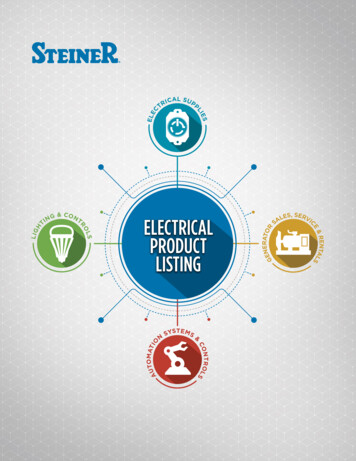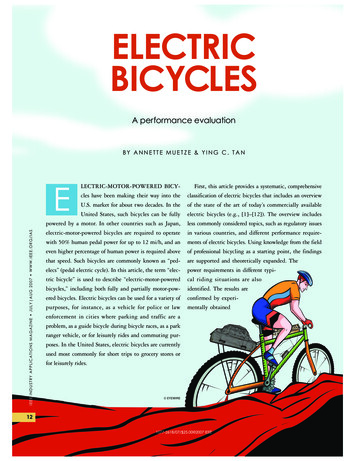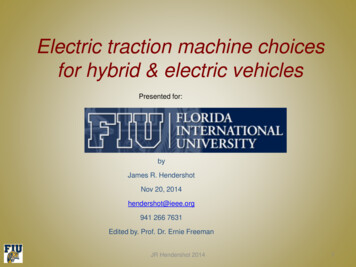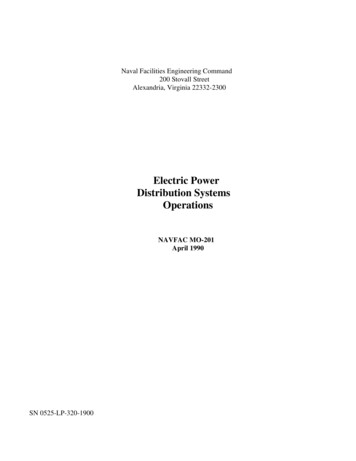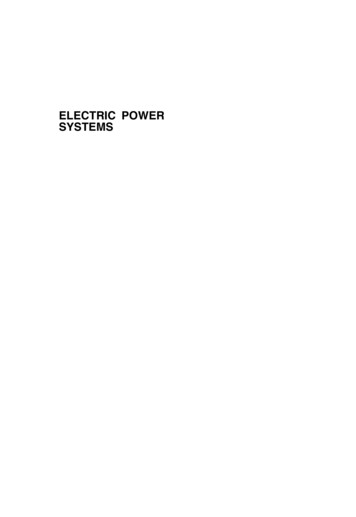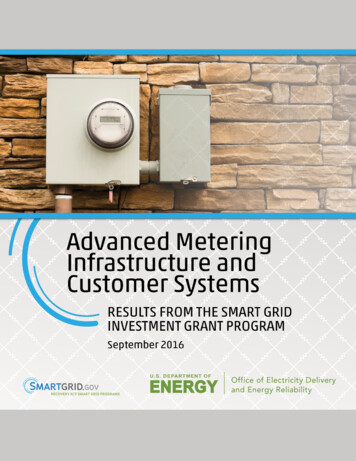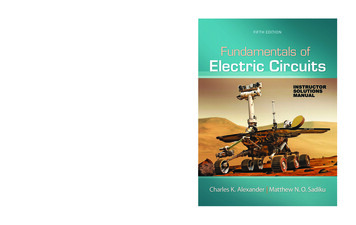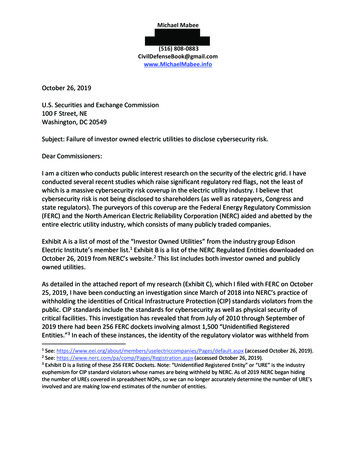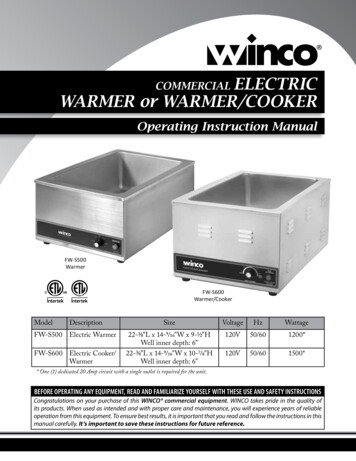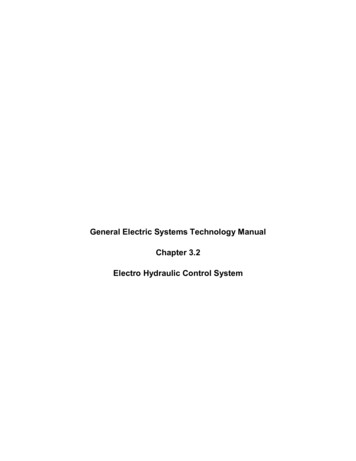
Transcription
General Electric Systems Technology ManualChapter 3.2Electro Hydraulic Control System
TABLE OF CONTENTS3.2 ELECTRO HYDRAULIC CONTROL SYSTEM. 13.2.1 Introduction . 23.2.2 Component Description . 33.2.2.1 Pressure Control Unit . 33.2.2.2 Speed Control Unit . 43.2.2.3 Desired Load Control Unit. 43.2.2.4 Valve Control Unit . 53.2.2.5 Hydraulic Power Unit . 63.2.3 System Operations. 83.2.3.1 Chest and Shell Warming . 83.2.3.2 Turbine Roll . 83.2.3.3 Normal Operation . 93.2.3.4 Power Maneuvering . 103.2.3.5 Plant Shutdown and Cooldown . 113.2.3.6 Pressure Regulator Failures . 133.2.3.7 Turbine Trips. 133.2.4 System Interfaces . 143.2.5 Summary . 14LIST OF TABLES3.2-1 Turbine Trip Conditions . 17Rev 09/113.2-iUSNRC HRTD
LIST OF 43.2-53.2-6Electro Hydraulic Control System LogicPressure Control UnitValve Control UnitSpeed Control UnitDesired Load Control UnitPressure Control SpectrumEHC Operator's ConsoleEHC System Hydraulic Power UnitEHC Fluid SuppliesMain Steam Line and EHC OrientationRev 09/113.2-iiUSNRC HRTD
3.2ELECTRO HYDRAULIC CONTROL SYSTEMLearning Objectives:1. Recognize the purposes of the Electro Hydraulic Control (EHC) system.2. Recognize the significance of reactor pressure control to boiling water reactoroperation3. Evaluate how the system operates to adjust turbine load in response to reactorpower changes.4. Recognize the relationship between reactor vessel pressure, turbine inlet pressureand pressure setpoint.5. Recognize the purpose of the following limiters:a. Load Setb. Load Limitc. Maximum Combined Flow6. Recognize the purpose, function and operation of the following EHC systemsubsystems:a. Pressure Control Unitb. Speed Control Unitc. Desired Load Control Unitd. Valve Control Unite. Hydraulic Power Unit7. Given Figure 3.2-1, evaluate how the system accomplishes the following:a. Normal steady state power operationsb. Power maneuveringc. Plant shutdown and cooldown8. Recognize how the Electro Hydraulic Control system interfaces with the followingsystems:a. Main Steam System (Section 2.5)b. Condensate and Feedwater System (Section 2.6)c. Reactor Protection System (Section 7.3)d. Turbine Building Closed Loop Cooling Water System (Section 11.5)Rev 09/113.2-1USNRC HRTD
3.2.1 IntroductionThe purposes of the EHC System are to: provide normal reactor pressure control by controlling steam flow consistent withreactor power control reactor pressure during startup, heatup, and cooldown evolutions, control the speed and electrical load on the turbine generator, provide protection for the main turbine, main generator and main condenser.The functional classification of the EHC System is that of a power generation system.Because a boiling water reactor operates as a saturated system, pressure changes canhave a pronounced effect on reactor power. If pressure is increased in a BWR duringpower operation, steam voids, which contribute significant negative reactivity to thecore, collapse, increasing core moderator density. This increase in moderation resultsin more thermal neutrons being available for the fission process increasing reactorpower. As reactor power increases, pressure increases even further, and a "snowballeffect" occurs. If reactor vessel pressure decreases, some of the moderator flashes tosteam. This flashing increases the void content in the reactor core resulting in negativereactivity and a reduction in reactor power. This reduction decreases reactor pressureeven further.Because of the effects mentioned above, a pressure control system was developed inwhich reactor power is first changed, followed by a change in turbine generator output.An increase in reactor power causes an increase in both reactor vessel and turbinethrottle pressure (Figure 3.2-6). This pressure increase is due to the increased heatgeneration by the reactor core producing more steam without a subsequent increase insteam flow rate. The throttle pressure increase is sensed by the pressure controlsystem. The pressure control system signals the Turbine Control Valves (TCVs) and/orByPass Valves (BPVs) to open wider, accommodating the increased steam production.This increase in turbine steam flow compensates for the reactor vessel pressure rise,and increases generator output.Reducing reactor power decreases reactor vessel pressure and turbine throttle pressure(Figure 3.2-6). The pressure control system responds to the decrease in throttlepressure by throttling the TCVs and/or BPVs decreasing turbine steam flow. Reducingsteam flow stops the steam pressure decrease and lowers generator output. Using thiscontrol system, the turbine follows or is "slaved to" the reactor.The EHC System has both electronic and hydraulic parts. The main EHC Systemcontrol logic, shown in Figure 3.2-1, positions the TCVs and BPVs to control the turbineinlet pressure, as indicated in Figure 3.2-2 and 3.2-6, and hence the reactor pressure.The operator controls and indications for the EHC System can be seen in Figure 3.2-3.Rev 09/113.2-2USNRC HRTD
In addition to normal pressure control, the EHC System also contains the electronic andhydraulic components necessary for positioning of the intercept (control valve) portion ofthe Combined Intermediate Valves (CIVs) and trip control of the TCVs, the interceptportion of the CIVs, Turbine Stop Valves (TSVs), and the stop valve portion of the CIVs.The EHC System hydraulic power unit is shown in Figure 3.2-4 while the various fluidsupplies are shown in Figure 3.2-5. Figure 3.2-6 shows the arrangement of the MainSteam System with respect to the EHC System.3.2.2 Component DescriptionThe major components of each Electro Hydraulic Control System are discussed in theparagraphs which follow.3.2.2.1 Pressure Control UnitThe Pressure Control Unit subsystem is part of the main EHC System logic and isshown in the lower left of Figure 3.2-1 and in Figure 3.2-1a. There are two pressureregulators, A and B. The pressure regulators are proportional type controllers, whichrequire a 30 psi difference between steam throttle pressure and the pressure setpoint(pressure error) to open the TCVs to the 100 percent steam flow position. The pressureat the steam throttle (turbine inlet) varies 30 psi from 0 percent steam flow to 100%steam flow, or 3.33% flow/psi. This is shown in Figure 3.2-2. Also shown is a curve ofreactor vessel pressure. This curve is not linear because of the pressure drops acrossthe flow restrictors, MSIVs, and steam line piping which are proportional to the square ofthe flow.The relationship between pressure error and steam flow was determined byexperimentation and gives a rapid response which is relatively stable. The pressureregulators compare the steam throttle pressure with the pressure setpoint (normally setat 920 psi) and generates a valve position demand based on the difference. If steamthrottle pressure is less than or equal to the pressure setpoint, the TCVs and BPVsreceive a closing demand signal from the Pressure Control Unit and remain closed.Each pressure regulator, A or B, has two summers associated with it. The first summerfor each pressure regulator receives the pressure setpoint signal (adjustable byincrease and decrease pushbuttons) and a bias signal and algebraically sums themtogether. The bias signal for the A regulator is 0 psig while the bias signal for the Bregulator is 3 psi. This places the A regulator in control and the B regulator in standby.The outputs of these first summers are sent to another set of summers where the steamthrottle pressure signals are added to this negative value. The outputs of these secondtwo summers are then sent to a High Value Gate (HVG) which passes only the highestpositive value of its two inputs. The signal from the A regulator is normally 3 psi greaterthan the signal from the B regulator because of different bias inputs. The output of theHVG is directed to the pressure to percent flow gain amplifier. Here the pressure errorsignal is converted to an equivalent percent steam flow demand signal. The gain of thisRev 09/113.2-3USNRC HRTD
amplifier is 3.33% steam flow for each 1 psi pressure error. The output of this amplifieris two of the inputs to the Valve Control Unit used for TCV and BPV positioning.3.2.2.2 Speed Control UnitThe Speed Control Unit subsystem is shown in the upper left of Figure 3.2-1 and inFigure 3.2-1c. It receives two turbine speed signals from the shaft speed pickups andcompares them to an operator chosen speed reference signal to produce two speederror signals. The Speed Control Unit differentiates one of the speed signals to producean acceleration signal. This is compared to an operator chosen acceleration referencesignal. The acceleration error signal is then integrated and sent to a Low Value Gate(LVG) which passes only the lowest value of its three inputs (2 speed errors and 1acceleration error) to produce two outputs. One output is applied to a 1.11%/RPM gainamplifier. This amplifier's output is one of the inputs to the Desired Load Control Unit forstartup and overspeed control. The other gain amplifier applies a 2.77%/RPM output tothe intercept portion of the CIVs for turbine overspeed control. The speed andacceleration setpoints are selected by the operator using pushbuttons. This SpeedControl Unit is primarily used for initial turbine startup to rated speed.During normal power operations when the turbine generator is synchronized to theelectrical grid, turbine speed is controlled by electrical grid frequency which is nominallyat 60 cycles/second (1800 rpm). Normal minor variations in grid frequency have noeffect on TCV positioning. Large changes in grid frequency (grid instability) or largereductions in generator load have the potential of overspeeding the turbine. In thiscase, the output of the Speed Control Unit can affect both TCV and Intercept Valvepositions.3.2.2.3 Desired Load Control UnitThe Desired Load Control Unit subsystem is shown in the upper right of Figure 3.2-1and on Figure 3.2-1d. The major part of the Desired Load Control Unit subsystem is theload set motor. The position of this motor is used to compute the final value of desiredload called the Load Set reference value. The purpose of the Load Set reference is toprotect the main generator from excessive loading, depending on conditions. Once theload set motor has been moved one way or the other and stopped, the load set remainsconstant until such time as the load set motor is again moved. The operator can controlthe position of the load set motor by using the load selector increase or decreasepushbuttons.The load set motor has a runback circuit which energizes the motor, under certainconditions, to run the load reference value down to zero. A runback to zero will occurany time synchronous speed (1800 rpm) is not the speed selected by the operator. Thisensures that the Speed Control Unit controls the turbine acceleration rate on a turbineroll. Another condition which causes a runback is the load reject circuit.Rev 09/113.2-4USNRC HRTD
The load reject circuit senses turbine power by measuring HP turbine exhaust pressure(crossover pressure) and generator load (stator amps). Whenever the load reject circuitsees a mismatch of 40%, a load rejection has occurred. The load set motor will runback towards zero as long as the mismatch exceeds 40%. This feature gives anelectronic follow up close signal to the TCVs which are also hydraulically closed by theload reject circuitry via fast acting solenoids.Finally, a loss of stator cooling signal will also cause the runback circuit to be activated.This runback is actuated by low inlet water pressure ( 13 psig) or high outlet watertemperature ( 95ºC) in the Stator Cooling Water System. The loss of stator coolingsignal insures proper cooling is available to cool the generator stator by causing arunback to 25% generator load as measured by stator amps.The load set value is always summed with any signal which may be coming from theSpeed Control Unit. The resultant output signal is a speed/load control signal that issent to the Valve Control Unit.There is also a line speed matcher circuit with the Desired Load Control Unit. Whenselected, it positions the load set motor to adjust turbine generator speed to synchronizethe generator frequency with that of the grid. The operator must manually close themain generator output breaker to complete paralleling to the grid.3.2.2.4 Valve Control UnitThe Valve Control Unit subsystem is shown in the lower right of Figure 3.2-1 and onFigure 3.2-1b. The Valve Control Unit subsystem establishes the steam flow demandsignals to the TCVs and to the BPVs. An integral part of the Valve Control Unit is thepressure/load LVG. The pressure/load LVG receives signals from the Pressure ControlUnit, the Desired Load Control Unit, the Load Limiter, the Maximum Combined FlowLimiter and the turbine trip logic. The values of the Load Limit and the MaximumCombined Flow Limit are determined by manual potentiometers. The Load Limit valueestablishes the maximum amount of rated reactor steam flow which is allowed to gothrough the turbine and is normally set at 100%. The purpose of the Load Limit limiteris to protect the main turbine from excessive steam flows/loads. The MaximumCombined Flow Limit establishes the maximum amount of rated reactor steam flowwhich is allowed to go to the condenser through the combination of the TCVs and theBPVs. The Maximum Combined Flow Limit is normally set at 105% on thepotentiometer. The purpose of the Maximum Combined Flow limiter is to protect themain condenser from excessive loading. The input from the Desired Load Control Unitis normally slightly greater than 100% (from the Load Set motor) unless other variablesrequire setting a lower Load Set value. The output of the pressure/load LVG is the TCVdemand. The inputs to the LVG ensure that TCV demanded position is modulated bythe Pressure Control Unit. This will make the turbine respond to changes in main steamheader pressure, thus making the turbine follow or slave to the reactor.Rev 09/113.2-5USNRC HRTD
The BPV demand is established by comparing the pressure/load LVG output to thePressure Control Unit output. The Small Close Bias prevents continuous opening andclosing of the BPVs. A BPV demand can be artificially created independent ofpressure/load conditions by means of the Cooldown Bypass Jack. Any difference issent to a LVG which also receives the difference between the Maximum Combined FlowLimit and the TCV demand. The Cooldown Bypass Jack is used during normalcooldown of the plant after the reactor is shutdown. The BPV demand is automaticallyadjusted to zero if condenser vacuum drops to a very low value ( 7" hg).3.2.2.5 Hydraulic Power UnitThe EHC Hydraulic Power Unit (HPU) shown in Figure 3.2-4 consists of a fluidreservoir, pumps, fluid coolers, strainers, filters, and accumulators. The pumps aremotor driven, variable delivery, piston pumps. Normally one pump is running with theother in standby. If the running pump fails, the standby pump will automatically startwhen system pressure decays. System overpressure protection is provided by reliefvalves at the discharge of each pump. The hydraulic drain lines from the various steamvalves are routed through tube and shell coolers which are cooled by the TurbineBuilding Closed Loop Cooling Water System.The HPU provides high pressure hydraulic fluid which is divided into several different oilsupply paths to various steam valves. The different oil paths are necessary to affectspecific valve responses for pressure control and turbine protection. Pressure control isaffected by positioning the TCVs and BPVs. Turbine protection against manypotentially unsafe conditions is provided by turbine trips. These are rapid closures ofthe TSVs accomplished by dumping the hydraulic fluid pressure which previously keptthe valves open. Large springs rapidly close the TSVs when the hydraulic oil pressureis removed. The stop valve portion of the CIVs will also trip closed on a turbine trip inthe same manner as the TSVs.The TCVs are rapidly closed upon a load rejection sensed by the load reject circuit asdescribed in section 3.2.2.3.The intercept valve portions of the CIVs, normally fully open, are throttled usinghydraulic fluid under certain overspeed conditions to provide turbine protection.There are five major hydraulic fluid streams developed by the hydraulic power unit. Thefive different streams are necessary to cause specific valve responses for pressurecontrol and turbine protection. These fluid streams and their affected valves can beseen in Figure 3.2-5. The Fluid Actuator Supply (FAS) is the fluid that hydraulically positions the:o stop valve portion of the CIVso BPVso and the TSVs.Rev 09/113.2-6USNRC HRTD
The Fluid Actuator Supply Trip Control (FASTC) is the fluid that hydraulicallypositions the:o TCVso intercept portion of the CIVs.The Fluid Jet Supply (FJS) is a high pressure fluid used to position spool valves thatport the FAS and FASTC actuating oil to the above valves.The Fluid Cooler Drains (FCD) is a common drain network which routes the variousoil stream drains back to the oil reservoir via the cooler.The Emergency Trip Supply (ETS) provides high pressure hydraulic oil to hold thedisk dump valves closed on the below listed valves. Rapid closure of these valves isaffected by a turbine trip signal which removes ETS from these disk dump valveswhich rapidly drains the hydraulic oil that opened the below valves against springpressure:o stop valve portion of the CIVso TSVsIn almost all cases of a turbine approaching some potentially damaging condition(including overspeed) the best protective action is to trip the turbine (i.e., close all steamadmission valves rapidly). This is accomplished by the Emergency Trip System shownin Figure 3.2-5. The turbine trip signals are described in Table 3.2-1.The ETS consists of three hydraulic valves connected in series and piped to a numberof actuating devices. The three valves are the mechanical trip valve, the lockout valve,and the master trip solenoid valve. High pressure hydraulic fluid from the HPU passesthrough these three valves and becomes the ETS fluid.When a turbine trip signal is generated, the ETS drains this fluid to cause fast closure ofall steam admission valves as described above. Release of ETS pressure also causesthe air relay dump valve to close. This closes the steam extraction line valves. Theseprevent reverse flow of the extraction steam returning back to the low pressure turbinesfrom the feedwater heaters (possibly causing the turbine to overspeed). All turbine tripsignals (except mechanical overspeed) seal in and require operator action to reset oncethe condition has cleared. ETS is also supplied to the relay trip valve which blocksactuating oil to the TCVs and the intercept portion of the CIVs allowing them to close inresponse to the trip signal. The ETS is failsafe, in that a loss of hydraulic fluid pressurewill result in closure of all the steam admission valves.Rev 09/113.2-7USNRC HRTD
3.2.3 System OperationsA short discussion of various system operating features is given in the paragraphswhich follow.3.2.3.1 Chest and Shell WarmingIf the High Pressure (HP) turbine shell inner temperature is less than 250ºF, it isnecessary to manually pre-warm the shell prior to rolling the turbine. The turbine mustfirst be placed on the turning gear to prevent/correct rotor bowing. Shell drains are alsoopened to remove condensate from the shell.Shell warming is used to minimize the differential expansion between rotating andstationary components of the HP turbine that may result in physical contact. It is alsodesirable to warm large metal components as much as possible to prevent combinedstress failure of these components because of the imposition of centrifugal and thermalstresses.When shell warming is selected, the intercept portion of the CIVs remain closed, thestop portion of the CIVs close (they open during turbine reset), and the TCVs are fullyopen. Crossover steam line drain valves close to permit shell pressurization. Thesevalves are interlocked open anytime "All Valves Closed" is selected. Selection of shellwarming overrides the open interlock. All other main steam line drain valves remainopen and do not impede shell pressurization because of the capacity of the #2 TSVinternal bypass. The bypass is capable of passing up to twice the steam flow requiredto maintain the turbine at rated speed with no load on the generator. The HP turbineshell is pressurized to between 60 and 100 psig via adjustment of the #2 TSV internalbypass (without rolling the turbine off the turning gear) and allowing the shell to "soak"until the desired temperature is reached.Even though some chest warming occurs during HP shell warming, chest warming isused to prepare the steam chest for the higher temperatures to which it will be exposed.The steam chest is the small interconnected volume between the TSVs and TCVs.Chest warming is accomplished by pressing the decrease pushbutton until the off lightunder shell/chest warming illuminates, then deselecting "Shell Warming" and selecting"Chest Warming". The TCVs then close and the stop portion of the CIVs open. Bypressing the increase pushbutton, steam is admitted to the chest through the #2 TSV'sinternal bypass.3.2.3.2 Turbine RollThe turbine is rolled by selecting the proper acceleration rate (depending on HP turbineshell inner temperature) and the desired speed, usually 1800 rpm. When this is doneseveral events take place. The speed error was zero while the “All Valves Closed”speed was selected and the acceleration demand signal was saturated high becauseRev 09/113.2-8USNRC HRTD
one of the acceleration rates is always selected. When a speed is selected, the twosections are both at full demand. As the unit starts to roll, the speed error and theacceleration error signals become smaller. Shortly into the turbine roll, the accelerationerror becomes the limiting signal thus controlling the rate of rise in turbine speed. Asthe turbine approaches the selected speed, the speed error becomes the limiting signalthus controlling the acceleration into and the overshoot of the selected speed. Atselected speed, the unit will modulate as speed varies slightly around the selectedspeed.3.2.3.3 Normal OperationIn the normal mode of operation with reactor thermal power at 100% and the generatorloaded to 100% capacity, a listing of the parameter and controller setpoint valuesfollows:Reactor powerGenerator powerReactor pressureThrottle pressurePressure setpointMaximum Combined Flow LimitLoad LimitTurbine speedLoad Set2436 MWt880 MWe1005 psig950 psig920 psig105%100%1800 rpm 100.1%The TSVs are fully open, and the TCVs are passing 100% rated steam flow. Both CIVs(the intercept valve and the stop valve portions) are fully open supplying low pressuresteam to the low pressure turbines.The pressure error signal is 30 psi, which corresponds to a 100% steam flow demand tothe TCVs and modulating on pressure control. Using Figure 3.2-1 the following shouldbe observed: Turbine speed error is 0 (1800 rpm) and acceleration error is maximum (0 rpm/min)resulting in a 0 output from the Speed Control Unit LVG. That 0 signal combines with a 100% bias signal and a 100.1% Load Set signalmultiplied 2.5 times to result in a 350% open signal to the intercept portion of theCIVs. The 0 signal also combines with the Load Set output of 100.1% resulting in a ValveControl Unit LVG input of 100.1% from the Desired Load Control Unit. The Pressure Control Unit is sensing 950 psig throttle pressure against a setpoint of920 psig resulting in a regulator output of 30 for the ‘A’ regulator and 27 (3 psi bias)for the ‘B’ regulator. The Pressure Control Unit HVG passes the 30 psi signal to the pressure to flowamplifier resulting in a 100% signal to the Valve Control Unit LVG and BPV summer.Rev 09/113.2-9USNRC HRTD
This being the low value in the Valve Control Unit LVG, it passes this value on toresult in a 100% steam flow demand to the TCVs and negates the same signal tothe BPV summer keeping all BPVs closed on the negative Small Close Bias signal.3.2.3.4 Power ManeuveringGenerator power changes are made by first changing reactor power and then allowingthe pressure change due to the power change to reposition the TCVs for the newgenerator output.Assume that the operator desires to reduce the reactor power to 80%. The core flowresulting in 80% reactor power is determined, and the control room operator then startsreducing recirculation flow to achieve the 80% reactor power. As flow is decreased,more boiling occurs in the core which adds negative reactivity and causes reactor powerand steam generation rate to decrease. The TCVs are still initially passing 100% steamflow. As the reactor attempts to continue to generate 100% steam flow, moderatortemperature and pressure decrease. As reactor pressure decreases, steam throttlepressure decreases causing a decrease in pressure error, As the pressure errordecreases, the TCVs begin to close. As the TCVs close, the pressure decrease isslowed because reactor steam flow is "catching up" with TCV position. Finally at 944psig steam throttle pressure, the pressure error is reduced to 24 psi which calls for 80%steam flow and corresponds to the steam generation rate the reactor can provide whilemaintaining criticality, and pressure no longer decreases. Final conditions are reactorpower 80%, turbine steam flow 80%, steam throttle pressure 944 psig, and pressureerror 24 psi. Note that neither the desired Load Control Unit nor the Speed Control Unitplayed any part in the change. Raising reactor power results in the opposite responses.Using Figure 3.2-1 the following 80% power steady state conditions are observed: Turbine speed error is 0 (1800 rpm) and acceleration error is maximum (0 rpm/min)resulting in a 0 output from the Speed Control Unit LVG. This 0 signal combines with a 100% bias signal and a 100.1% Load Set signalmultiplied 2.5 times to result in a 350% open signal to the Intercept Valves. This 0 signal also combines with the Load Set output of 100.1% resulting in a ValveControl Unit LVG input of 100.1% from the Desired Load Control Unit. The Pressure Control Unit is sensing 944 psig steam throttle pressure against asetpoint of 920 psig resulting in a regulator output of 24 for the ‘A’ regulator and 21(3 psi bias) for the ‘B’ regulator. The Pressure Control Unit HVG passes the 24 psi signal to the pressure to flowamplifier resulting in a 80% signal to the Valve Control Unit LVG and BPV summer. This being the low value in the Valve Control Unit LVG, it passes on to result in a80% steam flow demand to the TCVs and negates the amplifier signal to the BPVsummer keeping all BPVs closed.Rev 09/113.2-10USNRC HRTD
3.2.3.5 Plant Shutdown and CooldownThe turbine generator is normally unloaded prior to shutting it down. Reactor power isdecreased to a point well below the BPVs capacity ( 100 MWe generator load or 20%reactor power), and then the turbine trip pushbuttons are depressed causing a selectedspeed value of "All Valves Closed." The TSVs and TCVs fast close, the CIVs (stop andintercept) close, and the BPVs open in response to the valve control logic. The BPVsthen control reactor pressure. Using Figure 3.2-1 the following steady state conditionsare observed subsequent to the turbine trip: The turbine has been tripped (and assume stopped) so the turbine speed error is 0(all valves closed) and acceleration error is maximum (0 rpm/min) resulting in a 0output from the Speed Control Unit LVG. This 0 signal combines with a 100% bias signal and a 0% Load Set signal multiplied2.5 times to result in a 100% open signal to the CIVs. This signal is negated by aturbine trip 0 signal to the CIV's LVG resulting in a CIV closure. This Speed Control Unit 0 signal also combines with the load selector output of 0%resulting in a Valve Control Unit LVG input of 0% from the Desired Load ControlUnit. The Pressure Control Unit is sensing 926 psig throttle pressure against a setpoint of920 psig resulting in a regulator output of 6 for the ‘A’ regulator and 3 (3 psi bias) forthe ‘B’ regulator. The Pressure Control Unit HVG passes the 6 psi signal to the pressure to flowmultiplier r
e. Hydraulic Power Unit 7. Given Figure 3.2-1, evaluate how the system accomplishes the following: a. Normal steady state power operations b. Power maneuvering c. Plant shutdown and cooldown 8. Recognize how the Electro Hydraulic Control system interfaces with the following
